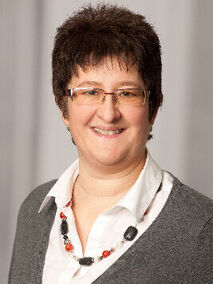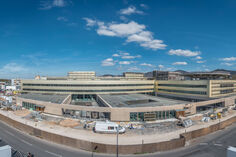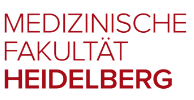Ärztlicher / Beruflicher Werdegang
- seit 2016
Gruppenleiterin der Experimentellen Paraplegiologie / Neuroregeneration, Klinik für Paraplegiologie des Departments Orthopädie, Unfallchirurgie und Paraplegiologie, des Universitätsklinikums Heidelberg
- 2014 – 2016
Klassenkoordinatorin und Dozentin, “Neuroregeneration and Neuro-tissue engineering”, Graduate Training Centre of Neuroscience, Universität Tübingen
- 2014 – 2016
Stellv. Gruppenleiterin und Ober-Postdoktorandin, Laboratory for NeuroRegeneration and Repair, Hertie Institut für Hirnforschung, Universität Tübingen
- 2007 – 2013
Postdoktorandin, Laboratory for NeuroRegeneration and Repair, Hertie Institut für Hirnforschung, Universität Tübingen
Wissenschaftlicher Werdegang
- seit 2017
Baden-Württemberg Zertifikat für Hochschuldiddaktik
- 2002 – 2006
Dissertation in Genetik an der University of Wisconsin-Madison, USA; PhD, Prof. Tomas Prolla:
“The role of mitochondrial heat shock protein 70kD in mammalian stress resistance”
- 1999 – 2002
Studium der Genetik an der University of Wisconsin-Madison, USA; M.Sc
2002 Lehrbescheinigung in Undergraduate Education from the Teaching and Learning Scholarship program, Universität von Wisconsin-Madison, USA
- 1994 – 1998
Studium der Molekularen Zellbiologie an der University of Michigan-Ann Arbor, USA; B.Sc und M.Sc
Stipendien
- seit August 2018
Olympia Morata Programme Medical Faculty Fellowship
Mitgliedschaften
Society for Neuroscience
Forschungsgelder
- seit 2015
SFB1158Pain: Von der Nozizeption zum chronischen Schmerz: Struktur-Funktions-Merkmale neuraler Bahnen und deren Reorganisation, A06 Funktionelle und strukturelle Plastizität nach Rückenmarksverletzungen und deren Beitrag zur Entstehung neuropathischer Schmerzen (Human-Tiermodell Tandem)
- 2018 – 2021
DFG: Modifikation und Transplantation anisotroper Kapillarengele für die gerichtete Regeneration nach Verletzungen des Rückenmarks
Wissenschaftliche Schwerpunkte
Regeneration im zentralen und peripheren Nervensystem
Neuronale Programme für axonales Wachstum
Zelltransplantation mit Neurotrophe Faktoren und Gentherapie
Biomaterialien
Mechanismen neuropathischer Schmerzen nach spinalem Trauma
Veröffentlichungen
Kennzahlen Google Scholar vom 15.04.2019:
Zitate: 697; h-index: 11; i10-index: 11
Hervera A, Zhou L, Palmisano I, McLachlan E, Kong G, Hutson TH, Danzi MC, Lemmon VP, Bixby JL, Matamoros-Angles A, Forsberg K, De Virgiliis F, Matheos DP, Kwapis J, Wood MA, Puttagunta R, Del Río JA, Di Giovanni S. (2019) PP4-dependent HDAC3 dephosphorylation discriminates between axonal regeneration and regenerative failure. EMBO J. May 22. doi: 10.15252/embj.2018101032.
Schackel T., Kumar P., Günther M., Liu S., Brunner M., Sandner B., Puttagunta R., Müller R., Weidner N. and Blesch A. (2018) Peptides and Astroglia Improve the Regenerative Capacity of Alginate Gels in the Injured Spinal Cord. Tissue Eng Part A. Dec 28. [Epub ahead of print] Link to article.
Sliwinski C., Nees T.A., Puttagunta R., Weidner N. and Blesch A. (2018) Sensorimotor Activity Partially Ameliorates Pain and Reduces Nociceptive Fiber Density in the Chronically Injured Spinal Cord. J Neurotrauma. Sep 15;35(18):2222-2238. Link to article.
Sandner B., Puttagunta R., Motsch M., Bradke F., Ruschel J., Blesch A. and Weidner N. (2018) Systemic epothilone D improves hindlimb function after spinal cord contusion injury in rats. Exp Neurol. Aug;306:250-259. Link to article.
Lou W.P., Mateos A., Koch M., Klussman S., Yang C., Lu N., Kumar S., Limpert S., Göpferich M., Zschaetzsch M., Sliwinski C., Kenzelmann M., Seedorf M., Maillo C., Senis E., Grimm D., Puttagunta R., Mendez R., Liu K., Hassan B.A. and Martin-Villalba A. (2018) Regulation of Adult CNS Axonal Regeneration by the Post-transcriptional Regulator Cpeb1. Front Mol Neurosci. Jan 12;10:445. Link to article.
Liu S., Schackel T., Weidner N. and Puttagunta R. (2018) Biomaterial-Supported Cell Transplantation Treatments for Spinal Cord Injury: Challenges and Perspectives. Front Cell Neurosci. Jan 11;11:430. Link to article.
Liu S, Sandner B, Schackel T, Nicholson L, Chtarto A, Tenenbaum L, Puttagunta R, Müller R, Weidner N, Blesch A. (2017) Regulated viral BDNF delivery in combination with Schwann cells promotes axonal regeneration through capillary alginate hydrogels after spinal cord injury. Acta Biomater. Sep 15;60:167-180. Link to article.
Joshi Y.$, Soria M.$, Quadrato G., Inak G., Zhou L., Hervera A., Rathore K., Elnagger M., Cucchiarini M., Marine J., Puttagunta R. and Di Giovanni S. (2015). The MDM4/MDM2-p53-IGF1 axis controls axonal regeneration, sprouting and functional recovery after CNS injury. Brain, Jul;138(Pt 7):1843-62. Link to article.
Lindner R., Puttagunta R., Nguyen T. and Di Giovanni S. (2014). DNA methylation temporal profiling following peripheral versus central nervous system axotomy. Scientific Data 1. Article number 140038. Link to article.
Puttagunta R.$, Tedeschi A.$, Soria M.G., Hervera A., Lindner R., Rathore K.I., Gaub P., Joshi Y., Nguyen T., Schmandke A., Laskowski C.J., Boutillier A.-L., Bradke F. and Di Giovanni S. (2014). PCAF-dependent epigenetic changes promote axonal regeneration in the central nervous system. Nature Communications 5: 3527. Link to article.
Lindner R., Puttagunta R. and Di Giovanni S. (2013). Epigenetic regulation of axon outgrowth and regeneration in CNS injury: the first steps forward. Neurotherapeutics. 10(4): 771-81. . Link to article.
Puttagunta R. and Di Giovanni S. (2011). Retinoic acid signaling in axonal regeneration. Frontiers in Molecular Neuroscience. 4: 59. Link to article.
Puttagunta R., Schmandke A., Floriddia E., Gaub P., Fomin N., Ghyselinck N. and Di Giovanni S. (2011). RA-RARß counteracts myelin-dependent inhibition of neurite outgrowth via Lingo-1 repression. The Journal of Cell Biology. 193(7): 1147-56. Link to article.
Gaub P., Tedeschi A., Puttagunta R., Nguyen T., Schmandke A. and Di Giovanni S. (2010). HDAC inhibition promotes neuronal outgrowth and counteracts growth cone collapse through CBP/p300 and P/CAF-dependent p53 acetylation. Cell Death and Differentiation. 17(9): 1392-408. Link to article.
Tedeschi A., Nguyen T., Puttagunta R., Gaub P. and Di Giovanni S. (2009). A p53-CBP/p300 transcription module is required for GAP-43 expression, axon outgrowth, and regeneration. Cell Death and Differentiation. 16(4): 543-54. Link to article.
Bomar J.M., Benke P.J., Slattery E.L., Puttagunta R., Taylor L.P., Seong E., Nystuen A., Chen W., Albin R.L., Patel P.D., Kittles R.A., Sheffield V.C. and Burmeister M. (2003). Mutations in a novel gene encoding a CRAL-TRIO domain cause human Cayman ataxia and ataxia/dystonia in the jittery mouse. Nature Genetics. 35(3): 264-9. Link to article.
Puttagunta R., Gordon L.A., Meyer G.E., Kapfhamer D., Lamerdin J.E., Kantheti P., Portman K.M., Chung W.K., Jenne D.E., Olsen AS. and Burmeister M. (2000). Comparative maps of human 19p13.3 and mouse chromosome 10 allow identification of sequences at evolutionary breakpoints. Genome Research. 10(9): 1369-80. Link to article.
Gutachtertätigkeit für Fachzeitschriften
Medical Research Council (MRC) of the UK Research and Innovation
Innovation and Technology Support Programme (ITSP), China
3 Biotech
Cell Transplantation
Pain
FEBS Letters
Acta Neurobiologiae Experimentalis
PLOS One
Scientific Reports
Neuroscience
Spinal Cord
Forschungssekretariat Klinik für Paraplegiologie
-

Ursula Wey
Sekretärin
Schwerpunkt
Sekretariat experimentelle Paraplegiologie und Oberärzte Paraplegiologie



